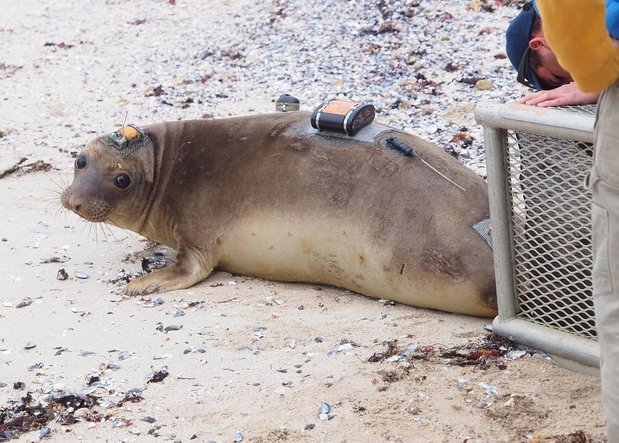Behavioral responses of marine mammals to anthropogenic noise
Behavioral responses of cetaceans to naval sonar
Human produced noise in the ocean is known to have behavioral and physiological impacts on a wide-range of marine mammal species. These effects range from ship noise masking vocalizations important for social communication to lethal mass stranding events associated with military sonar. Understanding how different species respond to different sound types, sound levels, and behavioral and environmental contexts are critical for effective conservation and management.
I was a member of the multi-year SOCAL-BRS (Behavioral Response Study) project that used animal borne tags to investigate the responses of large baleen whales and beaked whales to both operational and simulated military mid-frequency active sonar (MFAS). This work provided some of the first experimentally controlled measurements of behavioral responses to snoar exposure for several cetacean species.
I currently assist with a behavioral and physiological response study (BPRS) of social delphinds to operational and simulated MFAS. Because of the social, ephemeral nature of these species, conventional animal-borne tagging approaches aren't feasible or suitable. This project initially targeted common dolphins and is now focusing on bottlenose dolphins in the Southern California Bight. I quantify potential changes in acoustic behavior in response to sonar exposure treatments and collect shore-based group behavior metrics using a theodolite.
Left: Deploying the sound source elements used to project the simulated MFAS signal during a controlled exposure experiment. The AFFOGATO team conducting field work near Catalina Island the Southern California Bight. Right: Very happy to have both gliders back in the boat after 8 weeks surveying the Main Hawaiian Islands.
Relevant publications:
- Southall, BL, Allen, AN, Calambokidis, J, Casey, C, DeRuiter, SL, Fregosi, S, Friedlaender, AS, Goldbogen, JA, Harris, CM, Hazen, EL, Popov, V. (2023). Behavioural responses of fin whales to military mid-frequency active sonar. Royal Society Open Science, 10(12): 231775. doi:10.1098/rsos.231775 PDF
- Durban, JW, Southall, BL, Calambokidis, J, Casey, C, Fearnbach, H, Joyce, TW, Fahlbusch, JA, Oudejans, MG, Fregosi, S, Friedlaender, AS, Keller, NM, Visser, F. (2022). Integrating remote sensing methods during controlled exposure experiments to quantify group responses of dolphins to navy sonar. Marine Pollution Bulletin, 174: 113194. doi:10.1016/j.marpolbul.2021.113194 PDF
- Southall, BL, DeRuiter, S, Friendlaender, AS, Stimpert, AK, Goldbogen, J, Hazen, E, Casey, C, Fregosi, S, Cade, D, Allen, A, Harris, C, Falcone, E, Schorr, G, Moretti, DJ, Gailey, G, Guan, S, Calambokidis, J. (2019). Behavioral responses of individual blue whales (Balaenoptera musculus) to mid-frequency military sonar. Journal of Experimental Biology, 222(5): jeb190637. doi:10.1242/jeb.190637 PDF
Active acoustic playback tag
Measuring behavioral and physiological responses of marine mammals to anthropogenic noise exposures is notoriously difficult. Working with wild individuals and populations makis it hard to control for external factors and context, which have been found to be important in type and magnitude of response from some of the work summarized above. My master's research developed and tested a novel animal-borne tag that could act as both a passive acoustic sensor and active acoustic playback device to conduct in-situ controlled exposure experiments on free-ranging animals. We found that animals responded to all of the playback stimuli presented including potentially threatening sounds like transient killer whale vocalizations and sonar, as well as non-threatening sounds like white noise or sperm whale clicks. This strong response was likely due to the relatively 'unnatural' presentation coming suddenly from less than a meter behind the instrumented animals head. While we did not see differential responses by stimulus type, this tag has the potential to illicit responses similar to what an animal may exhibit following a real-world sound exposure and so could be used to provide insight into what these responses may look like behaviorally and physiologically.

A juvenile seal instrumented with the active acoustic playback tag is released following translocation across Monterey Bay. Research conducted under Permit #87-1743.
Relevant publications:
- Fregosi, S, Klinck, H, Horning, M, Mellinger, DK, Costa, DP, Mann, DA, Sexton, K, Hückstädt, L & Southall, BL. (2016). An animal-borne active acoustic tag for minimally invasive behavioral response studies on marine mammals. Animal Biotelemetry, 4:9. doi:10.1186/s40317-016-0101-z. PDF